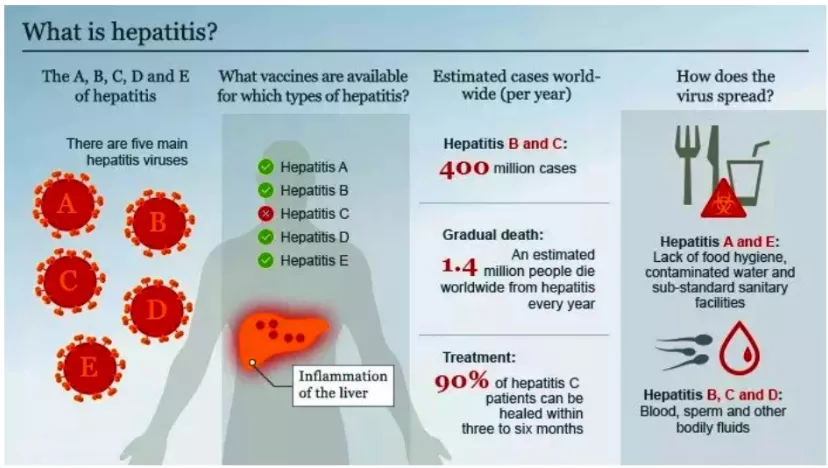Experts argue that Hepatitis A, now a leading cause of acute liver failure in India, deserves priority inclusion in the Universal Immunisation Programme (UIP).
What is Hepatitis?

- Hepatitis refers to inflammation of the liver, most commonly caused by viral infections.
- The major viral types are Hepatitis A, B, C, D, and E, each differing in mode of transmission, severity, prevention, and long-term complications.
- While Hepatitis B and C often lead to chronic liver disease, Hepatitis A and E generally cause acute, short-term infections, but can still lead to severe outcomes in vulnerable groups.
About Hepatitis A
- Hepatitis A is a viral liver infection caused by the Hepatitis A virus (HAV).
- Transmission: It is typically transmitted through the fecal-oral route, meaning that the virus spreads through contaminated food, water, or contact with an infected person’s stool.
- Symptoms: Patients commonly experience fever, fatigue, nausea, vomiting, abdominal pain, jaundice (yellowing of skin and eyes), pale stools, and dark urine.
- Prevention: Vaccination remains the most effective preventive tool. Improved sanitation, safe water supply, and strict food hygiene also significantly reduce transmission.
- Types of Vaccines: Two vaccine types are available, live attenuated and inactivated. Both provide 90–95% protection, and immunity lasts 15–20 years or even lifelong.
- Risk Factors:
- lack of access to safe water
- Travel to regions with poor sanitation
- Consumption of contaminated food or water
- Close household or school contact with infected individuals
- Children in overcrowded living conditions
Why Hepatitis A Needs Priority Attention
- Historically, Hepatitis A infected most Indians in early childhood, causing mild illness and conferring lifelong immunity.
- With improved sanitation, fewer children are exposed early, leaving adolescents and adults susceptible groups in whom Hepatitis A causes severe disease.
- Recent outbreaks in Kerala, Maharashtra, Uttar Pradesh, and Delhi have seen clusters of Acute liver failure, Hospitalisation and even deaths
Government Initiatives to tackle Hepatitis
- National Viral Hepatitis Control Programme (NVHCP):
-
- Launched to eliminate viral hepatitis as a public health threat by 2030.
- Focuses on awareness, testing, vaccination, surveillance, and treatment for Hepatitis A, B, C, D, and E.
- India’s Universal Immunization Programme (UIP): Hepatitis B is included under India’s UIP which provides free of cost vaccination.
- Private vaccination for Hepatitis A exists but is not universally accessible due to cost barriers.
- Indigenous Vaccine Development: India has developed its own Hepatitis A vaccine (Biological E’s Biovac-A), a live-attenuated vaccine, improving affordability and availability.
About Universal Immunisation Programme (UIP)
- Origin:
-
- Launched as the Expanded Programme on Immunization (EPI) in 1978.
- Renamed as the Universal Immunization Programme (UIP) in 1985.
- Aim: To provide free vaccination against preventable diseases to all children and pregnant women.
- Implementation: Vaccines are administered through government health facilities, private hospitals, and fixed immunisation sessions at Anganwadi centres and outreach sites.
- Administered by: Ministry of Health & Family Welfare
- Coverage: 12 vaccines are currently covered (including Measles, Polio, Pentavalent, HPV in selected states).
Mission Indradhanush (MI)
- Launched by: Ministry of Health and Family Welfare (MoHFW) in 2014.
- Objective: To ensure full immunization of all unvaccinated and partially vaccinated children under the Universal Immunization Programme (UIP).
|
![]() 14 Nov 2025
14 Nov 2025



